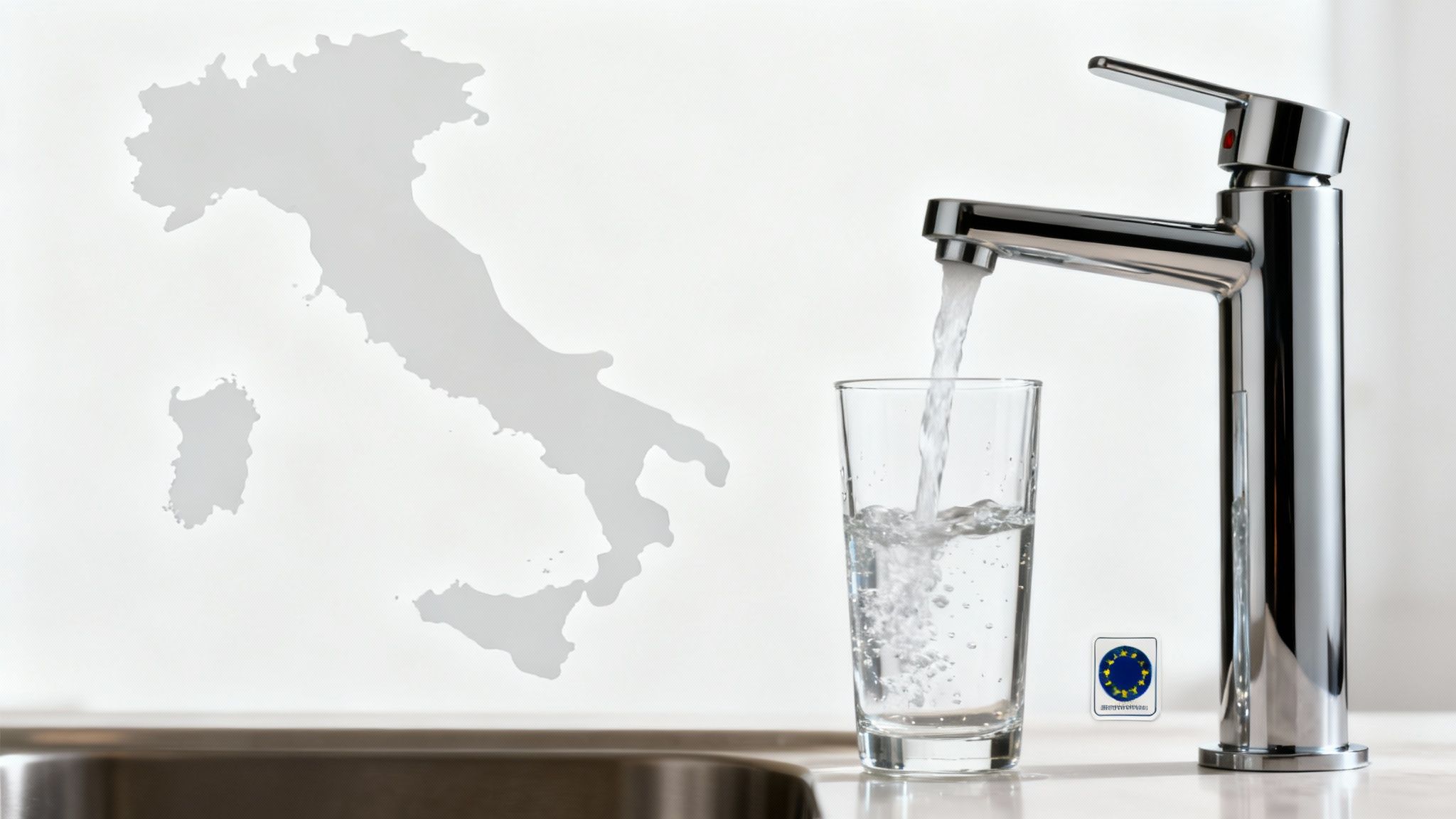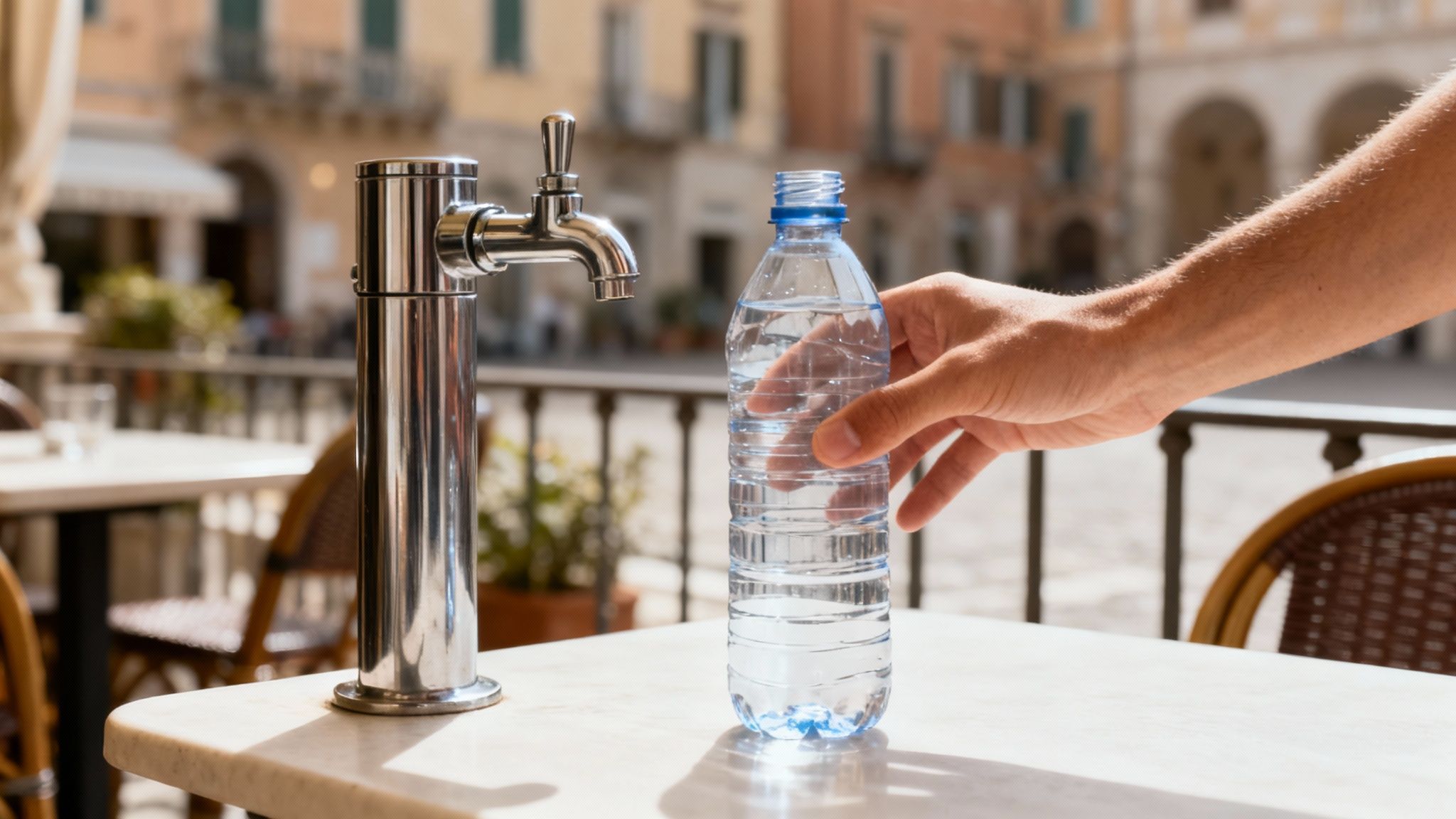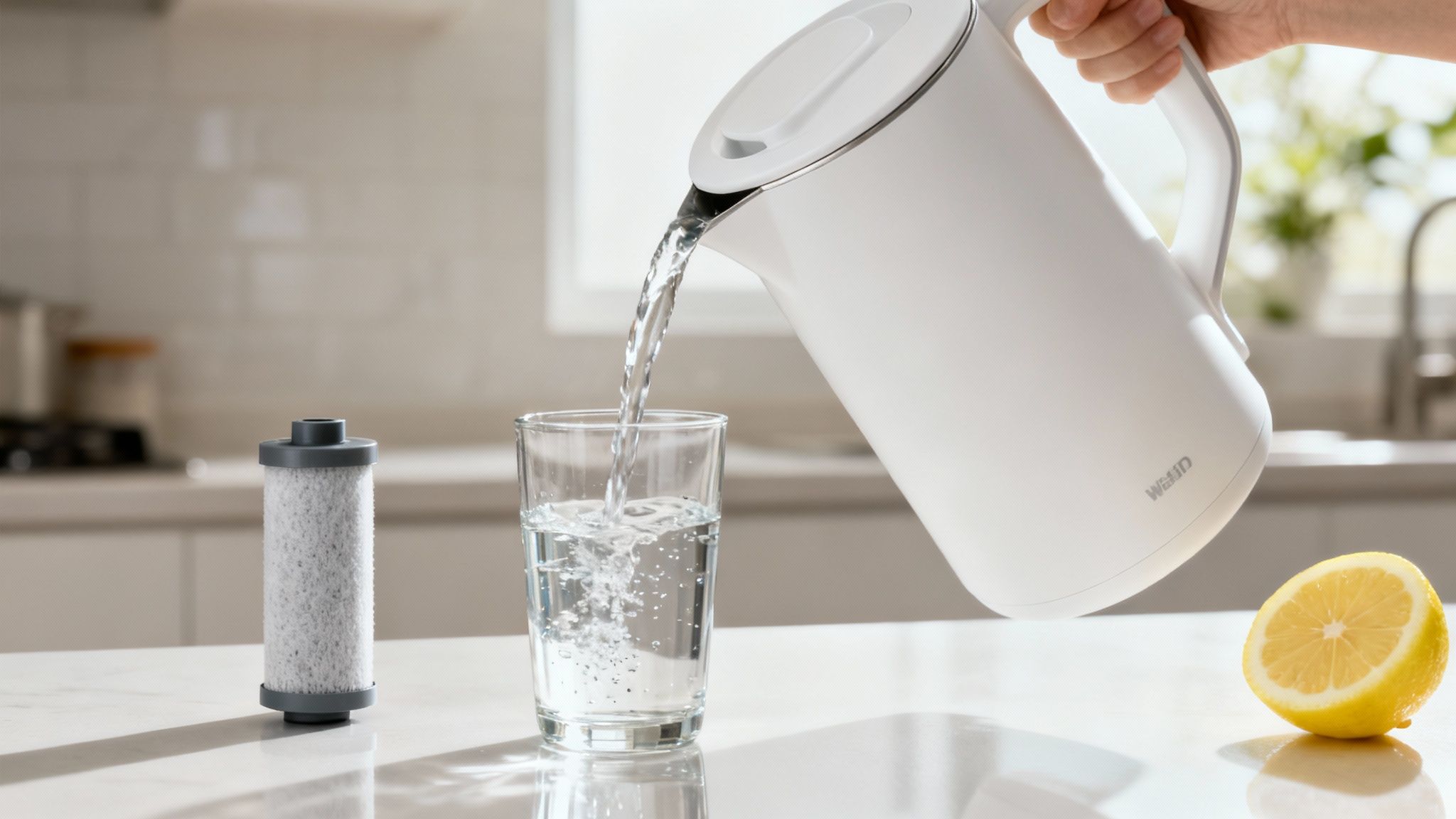
Is Tap Water in Italy Safe to Drink? A Practical Guide
Share
When visiting or living in Italy, a common question is: is tap water in Italy safe to drink? The short answer is yes. Italian tap water is generally safe and meets high-quality standards set by the European Union. Public water is treated and monitored, making it perfectly fine for drinking.
Quick Answer: Is Italian Tap Water Safe?
Yes, Italian tap water is safe to drink. Stringent EU regulations ensure it is thoroughly tested and treated. While many locals prefer bottled water for taste or habit, the public supply is clean and reliable. Concerns are usually about flavour, such as a slight chlorine taste, or hardness (limescale).

Understanding Italian Water Quality Standards
So, what makes the tap water safe? Italy adheres to the EU's Drinking Water Directive, a strict legal framework. This means the water that reaches your tap is tested frequently for a wide range of contaminants, ensuring it is healthy and clean.
A comprehensive report on Italian water quality from the National Center for Water Safety analyzed over 2.5 million tests. It found that 99.1% of all samples met legal safety standards. This confirms that the water in Italian homes is safe and sustainable.
This high standard is consistent across the country. However, local factors like the age of a building's pipes or mineral content can affect the water's taste. You can learn more in our guide to drinking water in Italy.
Italian Tap Water: A Quick Comparison
Here’s a simple table to summarise what you need to know. It's a handy reference for both travellers and residents.
| Factor | Status | Recommendation |
|---|---|---|
| Safety & Quality | Very High | Safe to drink directly from the tap in most locations. |
| EU Regulations | Fully Compliant | Water is treated and tested to meet strict European standards. |
| Taste & Odour | Variable | May have a slight chlorine taste or mineral flavour. |
| Regional Differences | Minor | Quality is consistent, but hardness (limescale) varies. |
With strong safety standards, you can feel confident turning on the tap. The main differences you might notice come down to personal preference, not health concerns.
Why Do Italians Often Choose Bottled Water?
If Italian tap water is safe, why does the country have one of the highest rates of bottled water consumption? The answer is a mix of culture, history, and taste preference. It has little to do with safety and more to do with habit.
This situation reveals a lot about Italian consumer habits. Even though science confirms the water is clean, old habits and regional skepticism remain. The result is a cultural norm that favours bottled water.

A Cultural Habit Passed Down Generations
For decades, the bottled water industry ran powerful marketing campaigns. They presented their product as purer and healthier than tap water. This message stuck, creating a lasting impression that tap water is a second-best choice. Bringing acqua minerale to the dinner table is as normal as bringing wine.
Despite evidence proving tap water is safe, a trust gap remains. Around one in three Italians does not trust their tap water. This feeling is stronger in southern regions like Sicily and Sardinia. You can dig deeper into Italian water consumption habits on olympianwatertesting.com.
The Role of Taste and Hardness
Beyond cultural habits, taste and hardness are real factors. Many people dislike the faint taste of chlorine, which is used to disinfect the public water supply. It is harmless, but some find the flavour off-putting.
The other major factor is water hardness, or limescale (calcare). This is caused by a high concentration of minerals like calcium and magnesium. While safe to drink, these minerals can cause practical issues:
- Appliance Damage: Limescale builds up inside coffee machines and kettles, reducing their efficiency and lifespan.
- Taste Alteration: Hard water can make coffee or tea taste chalky.
- Cleaning Hassles: It leaves white deposits on taps, shower screens, and dishes.
For many, choosing bottled water is an easy way to avoid the taste of chlorine and the battle with limescale. This is also why more people are exploring other solutions, like how a water cooler can improve your home setup.
What’s Actually in Your Tap Water?
Even when safe, tap water is never just pure H₂O. It contains a unique blend of substances that affect its taste, smell, and feel.
The most common addition is chlorine. Water suppliers use it as a disinfectant to kill harmful bacteria. It is essential for public health but is also why water can have a "swimming pool" smell.
The Story of Hard Water and Limescale
High concentrations of minerals like calcium and magnesium create "hard water." These minerals are safe to drink but are the main cause of limescale (calcare).
That chalky white crust inside your kettle is limescale. Over time, this build-up can clog appliances. Hard water also makes it difficult for soap to lather, which can affect your skin and hair. Learn more about how shower filters can help with hard water.
Emerging Contaminants to Watch
Beyond chlorine and minerals, there is growing discussion about other substances. You may have heard about microplastics and PFAS, often called "forever chemicals" because they do not break down easily.
Recent concerns over PFAS have led to new safety discussions. The EU has introduced stricter standards, setting a new limit of 0.5 µg/l for total PFAS in drinking water, effective by early 2026. You can find more detail on these upcoming changes in Italy here.
Filtration technologies like activated carbon are designed to capture a wide range of impurities, from chlorine to certain chemical compounds. A filter adds an extra layer of protection right at your tap.
When to Be Cautious with Tap Water
While Italy's municipal water is reliable, there are situations where you should be more aware. The issue is often not the public water grid but what happens in the final few metres to your tap.
Older Buildings and Historic Homes
The age of a building can be a factor. Italy is famous for its historic homes, but they may have old plumbing. Buildings erected before the 1960s might still have lead pipes. While public infrastructure is modern, individual buildings may not be.
Lead can leach from old pipes into the water. This is not a widespread problem, but it is a possibility in older flats. If you have concerns, let the cold tap run for a minute in the morning. This flushes out water that has been sitting in the pipes.
This quick guide helps you understand common tastes and smells.

A faint chlorine smell is normal—it’s the disinfectant at work. Water with no real taste is usually a great sign of its quality.
Private Wells in Rural Areas
Be cautious if your water comes from a private well (pozzo). These sources do not have the same mandatory testing as the public system. The water quality depends on local groundwater and maintenance. It can be pristine but is also more vulnerable to contamination. If you have a well, get it tested regularly. Our in-depth review of BRITA tap filters may offer a useful perspective on home filtration.
Guidance for Vulnerable Individuals
Some people should be extra careful. This is about minimising any potential risk. This group includes:
- Infants and young children.
- Pregnant women.
- Anyone with a compromised immune system.
For these individuals, using a high-quality water filter or sticking to bottled water provides extra peace of mind. It’s a simple, common-sense step.
Disclaimer: Home filtration complements—not replaces—professional advice. Always consult with a healthcare provider for health-related concerns.
Simple Steps for Fresher, Better-Tasting Water
Improving your water quality is surprisingly simple. Although Italian tap water is safe, a few adjustments can make a big difference to its taste and smell. You have options ranging from zero-cost habits to easy-to-install gadgets.

A Practical Checklist for Better Water
Start with these small, effective actions to upgrade your tap water.
- Let It Breathe: A common complaint about tap water is the smell of chlorine. A no-cost fix is to fill a jug and leave it in the fridge for a few hours. The chlorine will evaporate, leaving cleaner-tasting water.
- Chill It Down: Cold water tastes better. Lower temperatures help mask unwanted flavours from minerals or chlorine.
- Try a Water Filter Pitcher: A pitcher with an activated carbon filter is a great first step. They are affordable and help reduce chlorine taste. The only drawback is refilling and changing the cartridges.
- Upgrade to a Tap Filter: For more convenience, a tap-mounted filter is a great choice. It cleans water as it flows, giving you filtered water on demand. See the Water Filters kit that installs in minutes.
Choosing the Right Filtration System
When choosing a filter, consider your needs and kitchen setup. Tap filters offer a good balance of performance, convenience, and value. They connect to your tap and use a multi-stage process to capture impurities. Many use activated carbon to absorb chlorine and other compounds. Other stages might catch sediment or reduce heavy metals. This ensures the water you drink and cook with is consistently pure. You can explore different water filtration and purification options in our guide.
A tap filter’s main advantages are its continuous flow rate and longer filter lifespan compared to a pitcher. You get clean water instantly, and cartridges can last for months, making it a low-maintenance option.
Your Questions About Italian Water, Answered
Let's finish with some common questions about drinking water in Italy. Here are quick, straightforward answers for residents and travellers.
Is It Safe to Drink from Public Fountains in Italy?
Yes, for the most part. The famous cast-iron fountains in Rome, called nasoni, provide fresh drinking water from the same municipal supply as tap water. It is tested constantly. Look out for signs that say “Acqua Non Potabile” (Non-Potable Water). If you see one, do not drink from that fountain. These are usually decorative fountains that recycle water.
Can I Use Italian Tap Water for Coffee and Ice Cubes?
Absolutely. You can use tap water for making coffee, tea, and ice cubes. The water meets strict EU standards, so there is no health risk. The only thing you might notice is hardness. Hard water contains high levels of minerals, which can cause limescale to build up in appliances. It can also subtly change the flavour of your coffee. Many coffee lovers use a simple Water Filter to protect their machines and improve the taste.
How Can I Find a Water Quality Report for My Town?
Finding local water quality information is easy. By law, every water utility company in Italy must make this data public. Visit your local water provider's website. A quick search for your town's name plus "qualità acqua potabile" (drinking water quality) will usually lead you to a detailed report.
Do I Need a Filter for My Shower?
The water you shower with matters for your skin and hair. The high mineral content in hard water can leave a film that makes skin feel dry and hair look dull. A Shower Filter is a great solution. These filters are designed to reduce chlorine and some hardness minerals. Many people report softer skin and shinier hair. See the Shower Filters kit that installs in minutes.
At Modern Essentials, we believe everyone deserves clean, great-tasting water from their tap. Our easy-to-install filtration systems are designed to improve your water's taste and quality. Check sizes & refills — fast EU shipping.